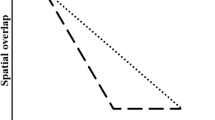Abstract
Social carnivores, such as wolves and coyotes, have distinct and well-defined home ranges. During the formation of these home ranges scent marks provide important cues regarding the use of space by familiar and foreign packs. Previous models for territorial pattern formation have required a den site as the organizational center around which the territory is formed. However, well-defined wolf home ranges have been known to form in the absence of a den site, and even in the absence of surrounding packs. To date, the quantitative models have failed to describe a mechanism for such a process. In this paper we propose a mechanism. It involves interaction between scent marking and movement behavior in response to familiar scent marks. We show that the model yields distinct home ranges by this new means, and that the spatial profile of these home ranges is different from those arising from the territorial interactions with den sites.
Similar content being viewed by others
References
Aronson, D. G. (1985). The role of diffusion in mathematical population biology: Skellam revisited, in Mathematics in Biology and Medicine, V. Capaso, E. Grosso and S. L. Paveri-Fontana (Eds), Berlin: Springer-Verlag, pp. 2–6.
Lewis, M. A. (1994). Spatial coupling of plant and herbivore dynamics: the contribution of herbivore dispersal to transient and persistent “waves” of damage. Theor. Popul. Biol. 45, 277–312.
Lewis, M. A. and J. D. Murray (1993). Modelling territoriality and wolf-deer interactions. Nature 366, 738–740.
Lewis, M. A., K. A. J. White and J. D. Murray (1997). Analysis of a model for wolf territories. J. Math. Biol. 35, 749–774.
Mech, D. L. (1991). The Way of The Wolf, Stillwater, MN: Voyageur Press.
Merti-Millhollen, A. S., P. A. Goodmann and E. Klinghammer (1986). Wolf scent marking with raised-leg urination. Zoo Biol. 5, 7–20.
Moorcroft, P. R., M. A. Lewis and R. L. Crabtree (1999). Analysis of coyote home ranges using a mechanistic home range model. Ecology 80, 1656–1665.
Murray, J. D. (1989). Mathematical Biology, Biomathematics 19, Berlin: Springer-Verlag.
Okubo, A. (1980). Diffusion and Ecological Problems: Mathematical Models, Biomathematics 10, Berlin: Springer-Verlag.
Parrish, S. (1998). Analysis of a home range model: pattern formation from scent-marking, Master’s thesis, University of Utah.
Peters, R. P. (1974). Wolf sign: scents and space in a wide-ranging predator, PhD thesis, University of Michigan, Ann Arbor, MI.
Peters, R. P. (1979). Mental maps in wolf territoriality, in The Behavior and Ecology of Wolves, E. Klinghammer (Ed.), New York, NY: Garland Press, pp. 119–152.
Peters, R. P. and L. D. Mech (1975). Scent marking in wolves. Am. Scientist 63, 628–637.
Rothman, R. J. and L. D. Mech (1979). Scent-marking in lone wolves and newly formed pairs. Anim. Behav. 27, 750–760.
Turchin, P. (1989). Population consequences of aggregative movement. J. Anim. Ecol. 58, 75–100.
White, K. A. J., M. A. Lewis and J. D. Murray (1996). A model for wolf-pack territory formation and maintenance. J. Theor. Biol. 178, 29–43.
White, K. A. J., M. A. Lewis and J. D. Murray (1998). On Wolf Territoriality and Deer Survival, Chap. 6, Springer Verlag, pp. 105–126.
Author information
Authors and Affiliations
Corresponding author
Rights and permissions
About this article
Cite this article
Briscoe, B.K., Lewis, M.A. & Parrish, S.E. Home range formation in wolves due to scent marking. Bull. Math. Biol. 64, 261–284 (2002). https://doi.org/10.1006/bulm.2001.0273
Received:
Accepted:
Issue Date:
DOI: https://doi.org/10.1006/bulm.2001.0273




